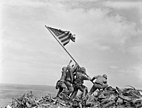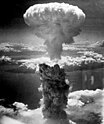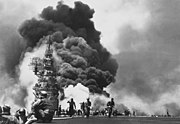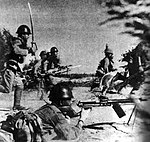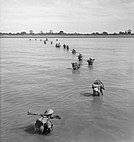This article contains several duplicated citations. The reason given is: DuplicateReferences detected: (November 2024)
|
| Pacific War | |||||||||
|---|---|---|---|---|---|---|---|---|---|
| Part of World War II | |||||||||
| |||||||||
| |||||||||
| Belligerents | |||||||||
| Main Allies:See section Participants for further details. | Main Axis:See section Participants for further details. | ||||||||
| Commanders and leaders | |||||||||
| Main Allied leaders | Main Axis leaders | ||||||||
| Strength | |||||||||
| Casualties and losses | |||||||||
The Pacific War, sometimes called the Asia–Pacific War or the Pacific Theater,[48] was the theater of World War II that was fought in eastern Asia, the Pacific Ocean, the Indian Ocean, and Oceania. It was geographically the largest theater of the war, including the Pacific Ocean theater, the South West Pacific theater, the Second Sino-Japanese War, and the Soviet–Japanese War in the last few months of the war.
The Second Sino-Japanese War between the Empire of Japan and the Republic of China had been in progress since 7 July 1937, with hostilities dating back to 1931 with the Japanese invasion of Manchuria.[49] However, it is more widely accepted[f] that the Pacific War itself began on 7 December (8 December Japanese time) 1941, when the Japanese simultaneously attacked American military bases in Hawaii, Wake Island, Guam, and the Philippines, the British colonies of Malaya, Singapore, and Hong Kong, and invaded Thailand.[50][51][52]
The Pacific War saw the Allies pitted against Japan, the latter aided by Thailand and to a lesser extent by the Axis powers, Germany and Italy. The Japanese achieved great success in the initial phase of the campaign, but were gradually driven back using an island hopping strategy. The Allies adopted a Europe first stance, giving first priority to defeating Nazi Germany. The Japanese had great difficulty replacing their losses in ships and aircraft, while American factories and shipyards produced ever increasing numbers of both. Fighting included some of the largest naval battles in history and massive Allied air raids over Japan, as well as the atomic bombings of Hiroshima and Nagasaki.
Japan surrendered unconditionally on 15 August 1945 and was occupied by the Allies. Japan lost its former possessions in Asia and the Pacific and had its sovereignty limited to the four main home islands and other minor islands as determined by the Allies.[53]
- ^ a b c Ch'i 1992, p. 157.
- ^ a b Sun 1996, p. 11.
- ^ Hastings 2008, p. 205.
- ^ Coakley & Leighton 1989, p. 836.
- ^ US Navy Personnel in World War II Service and Casualty Statistics, Naval History and Heritage Command, Table 9.
- ^ King, Ernest J. (1945). Third Report to the Secretary of the Navy p. 221
- ^ "US Navy Personnel in World War II Service and Casualty Statistics", Naval History and Heritage Command, Footnote 2.
- ^ a b Hastings 2008, p. 10.
- ^ "Chapter 10: Loss of the Netherlands East Indies". The Army Air Forces in World War II. HyperWar. Retrieved 31 August 2010.
- ^ Cherevko 2003, Ch. 7, Table 7.
- ^ Cook & Cook 1993, p. 403.
- ^ Harrison p. 29 Retrieved 10 March 2016
- ^ Australia-Japan Research Project, "Dispositions and Deaths" Retrieved 10 March 2016
- ^ Meyer 1997, p. 309.
- ^ Jowett 2005, p. 72.
- ^ www.navsource.org Retrieved 25 July 2015; www.uboat.net Retrieved 25 July 2015; Major British Warship Losses in World War II. Retrieved 25 July 2015; Chinese Navy Retrieved 26 July 2015.
- ^ Hara, Tameichi, with Fred Saito and Roger Pineau. Japanese Destroyer Captain (Annapolis: Naval Institute Press, 2011), p. 299.Figure is for U.S. losses only. China, the British Commonwealth, the USSR and other nations collectively add several thousand more to this total.
- ^ Dower 1986, p. 365.
- ^ see Malaya Campaign, Burma Campaign, Battle of Hong Kong, including Canadian troops
- ^ Kevin Blackburn, Karl Hack. “Forgotten Captives in Japanese-Occupied Asia”. 2007. Page 4. British Empire POWs are given a death rate of 25%.
- ^ "New Guinea: The US Army Campaigns of World War II ". For the New Guinea Campaign: 5,698 Australian casualties prior to January 1943, 17,107 between January 1943 and April 1944, and ~4,000 from April 1944 to the end of the war.
- ^ Dear, I.C.B; Foot, M.R.D. (2005). "Australia". The Oxford Companion to World War II. Oxford: Oxford University Press. p. 66. ISBN 978-0-19-280670-3.
- ^ Gruhl 2007, p. 65.
- ^ Kevin Blackburn, Karl Hack. “Forgotten Captives in Japanese-Occupied Asia”. 2007. Page 4.
- ^ /book/chapter5_10_1.html#5_10_51 "Russia and USSR in Wars of the 20th Century". И.И.Ивлев. Archived from /chapter5_10_1.html#5_10_51 the original on 5 May 2008. Retrieved 11 July 2008.
{{cite web}}: Check|archiveurl=value (help); Check|url=value (help) - ^ "Honouring NZ's Pacific War dead". Beehive. 15 August 2005. Retrieved 31 October 2010.
- ^ "Leyte Gulf: The Mexican Air Force". Avalanche Press. Retrieved 1 December 2015.
- ^ "Science and the Pacific War: Science and Survival in the Pacific, 1939–1945". Roy M. MacLeod (2000). p. 51. ISBN 0-7923-5851-1
- ^ "Chinese People Contribute to WWII". Retrieved 23 April 2009.
- ^ a b Dower 1993.
- ^ "Vietnam needs to remember famine of 1945". Anu. Archived from the original on 19 October 2017. Retrieved 31 October 2010.
- ^ Sen 1999, p. 203.
- ^ Gruhl 2007, pp. 143–144.
- ^ Clodfelter 2017, pp. 527.
- ^ McLynn 2010, p. 1.
- ^ Ruas, Óscar Vasconcelos, "Relatório 1946–47", AHU
- ^ Hara 2011, p. 297.
- ^ Hara 2011, p. 299.
- ^ USSBS Summary Report, p. 67. Retrieved 5/26/23. Approximately 20,000 in combat and 30,000 operational.
- ^ Bren, John (3 June 2005) "Yasukuni Shrine: Ritual and Memory" Japan Focus. Retrieved on 5 June 2009.
- ^ Rummel 1991, Table 5A.
- ^ Murashima 2006, p. 1057n.
- ^ Clodfelter 2002, p. 556.
- ^ Statistics of democide: Chapter 13: Death By American Bombing, RJ Rummel, University of Hawaii.
- ^ Gruhl 2007, p. 19.
- ^ E. Bruce Reynolds, "Aftermath of Alliance: The Wartime Legacy in Thai-Japanese Relations", Journal of Southeast Asian Studies, v21, n1, March 1990, pp. 66–87. "An OSS document (XL 30948, RG 226, USNA) quotes Thai Ministry of Interior figures of 8,711 air raids deaths in 1944–45 and damage to more than 10,000 buildings, most of them totally destroyed. However, an account by M. R. Seni Pramoj (a typescript entitled 'The Negotiations Leading to the Cessation of a State of War with Great Britain' and filed under Papers on World War II, at the Thailand Information Center, Chulalongkorn University, p. 12) indicates that only about 2,000 Thai died in air raids."
- ^ Murray & Millett 2001, p. 143.
- ^ MacLeod 1999, p. 1.
- ^ Drea 1998, p. 26.
- ^ Costello 1982, p. 129–148.
- ^ Clodfelter 2002, p. 585.
- ^ Takemae 2003, p. 516.
Cite error: There are <ref group=lower-alpha> tags or {{efn}} templates on this page, but the references will not show without a {{reflist|group=lower-alpha}} template or {{notelist}} template (see the help page).
Cite error: There are <ref group=nb> tags on this page, but the references will not show without a {{reflist|group=nb}} template (see the help page).
